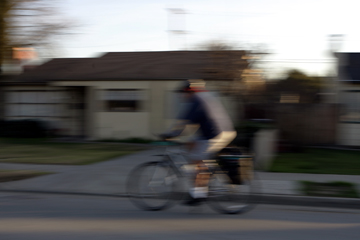
Diabetic crisis brings couple to change
One of Rob Galindo’s most vivid childhood memories revolves
around a sack full of newspapers, his mother and a plate full of
warm homemade flour tortillas.
Diabetic crisis brings couple to change
One of Rob Galindo’s most vivid childhood memories revolves around a sack full of newspapers, his mother and a plate full of warm homemade flour tortillas.
He was a paper boy, and after he finished delivering to the homes on his route in downtown Hollister, Rob would come home to the pre-dinner snack his mother had waiting for him – a dozen tortillas accompanied by a huge bowl of refried beans. He would eat his “snack” while doing homework, and then sit down to dinner, usually more tortillas and beans. His eating habits while growing up, Rob recalls, were not the healthiest.
Leticia Galindo ate much the same way Rob did as a child, but for her, there was an added complication – diabetes.
“My dad had it, my mom had it, my brother had it,” Leticia said. “There was no way I wasn’t going to end up with diabetes too. I just didn’t want to admit it.”
Today, Rob, 39, and Leticia, 29, are married, and being overweight is a struggle the couple has shared since long before they first met in 2002 at a birthday party for her brother Robert, one of Rob’s co-workers. Rob calls himself a yo-yo dieter who loves to ride his bicycle, while Leticia says she has tried many diets over the years with very little success.
“A friend once told me, ‘You want to learn how to lose weight? Ask a fat person.’
I thought it was funny at first,” Rob said. “But when you really think about it, it’s true. I have lost over 100 lbs. twice.”
But a recent health scare, which resulted in Leticia being hospitalized due to complications from her diabetes, forced the Galindos to take a hard look at what they eat and commit to making serious changes.
“My wife means the world to me,” Rob said. “By setting an example, and trying to lose weight too, I can help her. We aren’t really calling this a diet. It’s a lifestyle change.”
Growing up ‘fat’
In spite of being heavy for his age (“I was always over 200 pounds”), Rob was very active, taking part in several organized sports, including football, baseball and soccer. As a freshman he played football for San Benito High School, but a year later, his interests moved from athletics to music, which ultimately affected his weight.
Despite her family’s struggle with diabetes, Leticia’s eating habits weren’t much better. Although her parents tried to teach their daughter what foods she should be eating, Leticia said she didn’t like limiting what she ate.
“I was in denial,” she said. “I didn’t take [diabetes] seriously and it is a serious disease. Diabetes is scary.”
Leticia was working at McDonald’s when she began dating Rob, and the pair would often sit down to Big Macs and fries after Leticia finished her shifts. They began dating, and dates typically included eating out and little physical activity.
“We ate out three or four times a week,” Rob said. “We love pizza, so we would go out for pizza a lot, and not just any pizza – we would go for the really good pizzas at Italian restaurants, loaded with all kinds of toppings.”
By the time the couple married in 2005, both had put on extra weight – Rob in particular, who weighed around 320 pounds on his wedding day. Then, while on their honeymoon, Rob hurt his back “horsing around” in the pool. The injury was so severe he underwent surgery a year later.
“After my surgery, the doctor told me to take it easy,” he said. “I took it a little too easy – I put on another 45 pounds. I reached 364-1/2 pounds, the most I’ve weighed ever.”
‘Food was my happiness’
By 2007, Leticia was taking five different types of medication daily in an attempt to control her diabetes, including three types of insulin and pills for her high cholesterol. She was trying to watch what she ate, but quickly discovered she didn’t have Rob’s willpower when it came to saying no to the foods she loved.
“Food was my happiness,” she said. “I was the one who would say I wanted pizza, and he would give in because he wanted to make me happy.”
“The flip side of that was I used her as my excuse,” Rob added. “Secretly, I wanted pizza too, but I would wait and if she wanted it, then it felt OK to me and we’d go.”
After his back surgery, Rob changed his eating habits and began exercising more, setting a goal to lose yet another 100 lbs. Keeping his wife’s diabetes in mind, Rob created a diet for the couple to follow.
“I’m a bit of a bookworm, and I’ve always felt compelled to read books on losing weight, so I’ve picked up a lot,” Rob said. “I’ve tried to incorporate what works for me with her diet plan, which has a lot of whole wheat pasta, whole wheat bread and veggies.”
Leticia, however, was still eating whatever she wanted when Rob wasn’t around. To make up for the bad foods she ate, Leticia said she would double the amount of insulin she was taking that day.
Rob would ask his wife every day if she had taken all of her medications, and Leticia said she never let on about the inconsistent way she was dosing herself.
“He would ask, and I would lie to him,” she said, quietly. “It was the one thing that hurt – I was lying to my husband.”
Her lies caught up to her in January 2007, when her actions landed her in the emergency room at Hazel Hawkins Hospital, her body worn down from the diabetes.
“When I first saw her lying there, she was in tears,” Rob said. “She was upset with herself. She just kept telling me that she was sorry for not taking care of herself.”
Shortly after Leticia was released from the hospital, Rob went through the couple’s kitchen cabinets, throwing out or giving away everything that was “bad” for his wife. He bought a juicer so that he could make fresh fruit juice and fruit smoothies with soy protein, and began shopping the health/natural foods section at Nob Hill.
“We tease each other that we are the ‘wooden floor’ shoppers,” Rob said, referring to the flooring along supermarket natural foods and produce areas. “We’re really following Dr. Percival’s advice. We got rid of our dinner plates and bought smaller ones, so that our plates look full. We buy whole wheat instead of multi-grain, because with multi-grain you don’t really know how much of each grain you are getting. We’ve learned to read labels. Before, I would buy fat-free products without thinking, but that can be deceiving, because a lot of times fat-free really means loaded with sugar.”
‘I have to change if I want to live’
A typical day’s menu for the Galindos includes plenty of whole grains and fresh fruits and vegetables. The couple pays close attention to portion sizes, the amount of sugar in each item they consume and proper combination of foods (not mixing sugars and starches, for example.
“It’s all about portion control,” Rob said. “Like with pretzels, I fix myself a portion and that’s all I get. If you eat straight out of the bag, you always eat too much.”
“We use a lot of baggies,” Leticia added. “I’ll buy a big bag of carrots and after we put away the groceries, we’ll wash them, count out portions and then put them in baggies. We do it with grapes and celery, too. That way a snack is always ready.”
In December 2007, Leticia’s doctor decided she was a candidate for gastric bypass surgery. Leticia said her doctor told her that the surgery is being looked at as a possible way to help diabetics reduce sugar levels by controlling their appetites. She had the surgery Dec. 21, 2007, and although she feels fine now, Leticia said at first the surgery made her feel terrible.
“For two weeks I couldn’t eat solid food, and it was Christmas. I was crying all the time; I was depressed,” she said. “I couldn’t believe I had given so much power to food.”
Leticia credits her husband with helping her get through the surgery, as well as helping her realize she was capable of making the necessary changes to save her life.
“His will power is so strong. He inspires me,” she said. “This is the first time my sugar levels have been under control since 2002.”
Today, Rob weighs around 277, a loss of more than 87 pounds. He rides his bike every day from his home on Marne Drive to Pride Conveyance Systems on Shelton Drive, where he works as a drafter/designer. Leticia is eating smaller portions, thanks to the surgery and her husband’s support, and is learning to enjoy her new diet.
At night, Rob and Leticia take walks together with Tonka, the couple’s dog, a mastiff-pit bull mix. Weekends are spent shopping, biking, walking with Tonka and working out in their new home gym, complete with an ab roller, a small weight bench, hand weights and an elliptical machine.
“I’ve learned a lot from my past mistakes. Before, I’d try these fad diets, or I’d fast and drink nothing but water, or I would exercise all of the time,” Rob said. “But there is no quick fix. I have to change if I want to live. And to do that, I just have to do what (fitness expert) Jack LaLanne has said all along – eat right and exercise.”
By the numbers:
1 San Benito County is ranked first out of 58 counties in California for childhood obesity
35% The number of San Benito County residents who are overweight
8 million Approximate number of Americans classified as severely obese
15,500 Number San Benito/Monterey county residents diagnosed with diabetes as of January, 2004
20.8 million Number of Americans with diabetes as of December, 2005
8 Number of diabetes related deaths in 2005 in San Benito/Monterey counties
224,000 Number of diabetes related deaths nationwide in 2006; diabetes is the sixth leading cause of death in the United States
$132 billion Annual cost of diabetes in the United States
Candidate for diabetes:
Diabetes often goes undiagnosed because many of its symptoms seem harmless. Of the 20.8 million Americans with diabetes, almost 8 million of those are undiagnosed cases, according to the The Centers for Disease Control and Prevention (CDC).
Recent studies indicate that the early detection of diabetes symptoms allows patients to seek treatment, which in turn decreases the chance of developing the complications of diabetes. Diabetes symptoms include: frequent urination, excessive thirst, extreme hunger, unusual weight loss, increased fatigue, irritability and blurry vision.
Anyone experiencing one or more of these symptoms should see their doctor as soon as possible. To take an online Diabetes Risk Test, go to the American Diabetes Association Web site at www.diabetes.org.









